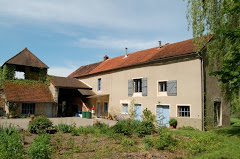Blog of La Tuilerie de Chazelle by Sue

Before I start my Blog on the Voie Verte, I would like to point out another Blog of La Tuilerie. That one has a slightly more spiritual line of approach (See link above).
The Voie Verte (Green Trail, or Green Track) is a cycle path that roughly runs North South through Saône-et-Loire (71), Southern Burgundy. In the mid nineties the Conseil Général of Saône-et-Loire decided to tarmac the old railway between Chalon-sur-Saône and Mâcon, and turn some of the stations along the railroad into service stations. This concept turned out to be such a success, that the original 80 km of track has been extended to a network of 320 km of cycle routes, with an 28 additional boucles or circuits totalling approx. 730 km. The network uses not only derelict railroads; towpaths along the canals are converted into cycle paths, and several cycle paths have been specially build to connect the various tracks.
The boucles all start from the Voie Verte, and each boucle is marked per degree of difficulty on a scale of 1 (easy) to 4 (very hard work). In various places, such as the old stations of Cluny and Saint-Gengoux-le-National, the tourist office in Saint-Gengoux-le-National and the Camping Municipal of Cormatin one can hire bicycles for the unlucky ones who did not bring them themselves.
We always advise our campers and gîte guests to bring their own bikes. Not only is that al lot cheaper, but I always feel more comfortable on my own bike, no matter how good and well maintained rented bikes can be. Bikes here can be rented for 1 or 2 hours, 1, 2 or 4 days, or by the week. The prices vary per time span, but as an indication they are € 18 per day and € 54 per week.
It is already possible to do a Tour de Bourgogne, at present 600 km long, in the near future 800 km long.
 The concept of Voie Vertes reaches much further than just Saône-et-Loire or Burgundy. There are certainly plans to connect the various cyclepaths in Burgundy and Rhône, and e.g. Brittany also has its own Voie Verte system.
The concept of Voie Vertes reaches much further than just Saône-et-Loire or Burgundy. There are certainly plans to connect the various cyclepaths in Burgundy and Rhône, and e.g. Brittany also has its own Voie Verte system.The Voie Verte lies only 2 km from our property, and boucles 10 and 10 bis (Romanesque churches Circuit) pass by La Tuilerie de Chazelle at 200 m.
Cycling however is not restricted to the cycle paths. The secondary roads in this part of Burgundy are relatively quiet, and cars, when overtaking a cyclist, should leave 1.5 m clearance between car and bicycle. Most French adhere strictly to this rule. When I cycle to the baker in the morning, I normally take the main road (D981). It is not unusual that I generate a trail of cars behind me, because they cannot overtake! And when somebody passes you very closely, 9 out of 10 times it is a Dutch driver, because Dutch drivers know how overtaking can be done closely without causing danger, at least when dealing with Dutch cyclists. British cyclists are not that keen on being overtaken that closely, I know from experience.
For those who like to watch cycle races, they can be lucky. In 2007 the Tour de France came through Cormatin, and only a few weeks ago the Route de Saône-et-Loire raced through Cormatin. Even for the passive tourists Cormatin has got something to offer!
Some more photographs of the Voie Verte






